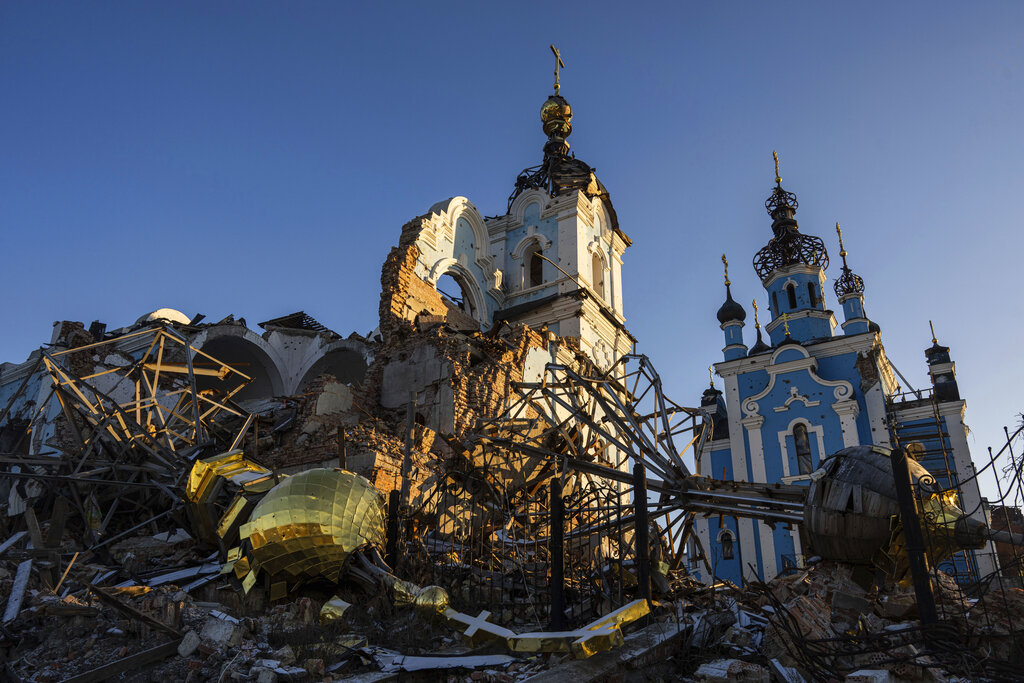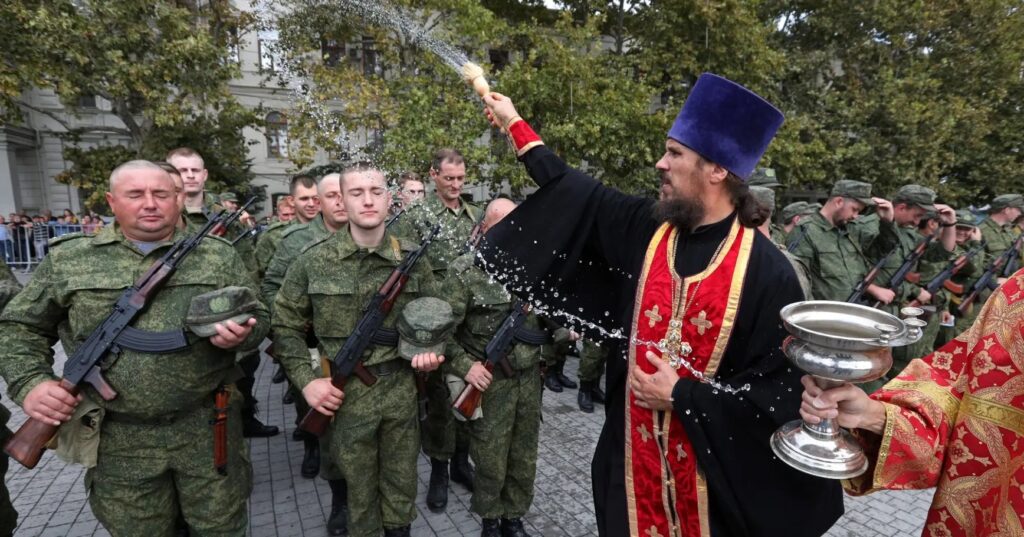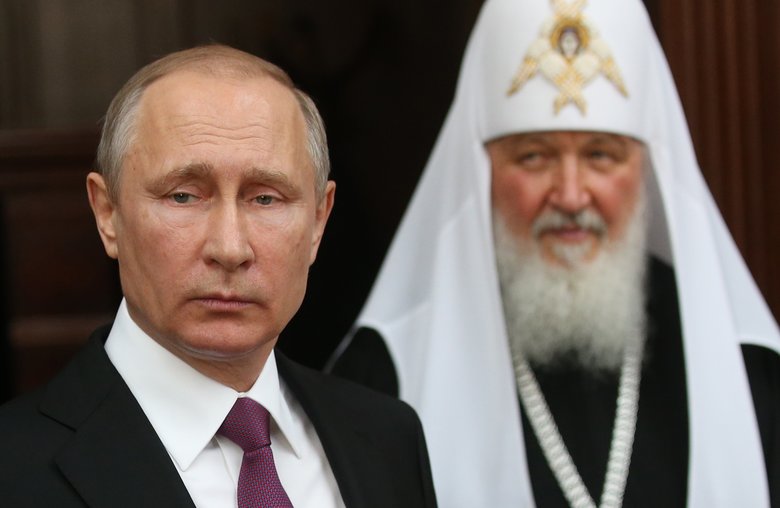Ukraine’s Orthodox Churches as a Battleground in Russia’s Invasion
Orthodox Christianity’s place in Russia’s war against Ukraine

(An Orthodox church in Ukraine destroyed by Russian forces. Image source: Evgeniy Maloletka for Associated Press)
In Odessa, a missile strike in July 2023 sent fourteen people to the hospital, including four children. The attack pulverized a sacred site – Holy Transfiguration Cathedral, the spiritual center of Odessa’s Russian Orthodox Church in Ukraine (ROCU). And while Russia’s assaults on Ukraine have taken civilian lives, the attack on the cathedral was a warning shot – they were taking aim at Ukraine’s Orthodox soul.
Russia claims there is no difference between Ukrainians and Russians. Russian political elites point to their common spiritual heritage as a symbol of their unity. So, why would Russia attempt to destroy a cathedral they claim as their own? The reason: Russia believes Ukraine has betrayed its ancestral unity by creating its own independent Orthodox church.
Besides this feeling of religious betrayal, many factors motivated Russia’s invasion of Ukraine: Putin’s desire to make Russia into a worthy successor of the imperial and Soviet eras; Russia’s dislike of the West and America in particular; Putin’s hope to reconfigure the energy market to strengthen Russia and punish Europe; and, Russia’s desire to punish Ukraine for its aspirations to distance itself from Russia and establish an anchor in Europe.
All along, Ukraine was central to the success of Putin’s initiatives. Annexing the resource-rich portions of Ukraine would help Putin strengthen Russia and enhance its influence in the energy sector. Occupying Ukraine would also permit Russia to expand its ideological sphere and attempt to transform Ukraine into a nation that rejected European values.
The invasion has gone far beyond a mighty force subduing a smaller and weaker army. Russia has indiscriminately killed civilians, raped women, kidnapped children, and targeted nuclear facilities. Putin has been charged with war crimes.
What has animated such a bloody war with broad Russian support?
The answer, sadly, is hate.
The Russian Orthodox Church (ROC) has been a vehicle for promoting hate of Ukrainians. Their leader, Patriarch Kirill, fanned the flames of hatred less than two weeks after the invasion when he justified the war on the grounds of a metaphysical battle between good and evil.

(An Orthodox priest conducts a service for Russian soldiers. Image source: Alexey Pavlishak for Reuters)
The origins of Russian enmity toward Ukraine are complicated. Historically, Russia and Ukraine can legitimately trace their beginnings to the historic state of Kyivan Rus’. Kyivan Rus’ takes its name from Kyiv, one of the small city-states that adopted Orthodox Christianity in the late tenth century. Vladimir-Suzdal, a principality that succeeded Kyivan Rus’, became the most important city-state in the northeast at the end of the thirteenth century after Mongolian invasions ruined Kyiv. By the time Moscow achieved primary power in the northeast, Kyiv was part of the Polish-Lithuanian Commonwealth, with an Orthodox minority in Catholic realms.
Modern Ukrainian identity is largely Central European, shaped by encounters with Poland and Austria. Modern Russian identity, in contrast, derives from the initial formation of a ruling imperial dynasty in the fifteenth century.
While Ukraine and Russia have common origins in the medieval city-states of Rus’, their encounters reflect a mixture of cooperation and coercive subjugation. For example, in the seventeenth century, the Ukrainian leaders of the Cossack hetmanate in Poland were tired of Catholic policies that favored Orthodox converts to Catholicism. Ukrainians made a treaty to accept the protection of the Russian tsar at Pereiaslav in 1654.
Ukrainians benefitted from the treaty, at least initially. Their shared faith and patrimony with Russia granted them access to coveted positions in the Church and the imperial governing apparatus. Ukrainians became high-ranking officers in the imperial court. They were educated in the finest institutions in Europe. Many Ukrainians affirmed their fraternal bonds with Russia, anchored in their Rus’ ancestry.
But Russia’s patronage of Ukraine came at a price. Beginning with Tsar Peter 1, Russian rulers absorbed Ukraine ever more deeply into Russia’s control. Under Catherine II, Russia began to “russify” Ukraine, attempting to blot out Ukrainian identity. Russification continued and intensified in the 19th century during the reign of Tsar Nicholas I.
Russia responded ferociously to any Ukrainian challenges to Russia’s place as the dominant partner in the relationship. It used the Church as a vessel both to punish and control Ukrainians. In 1709, the Russian Orthodox Church anathematized the leader of the Ukrainian Cossack regiment, Hetman Ivan Mazepa. Anathematization is the most severe punishment the Church imposes. It is reserved for apostates and heretics – people who either betrayed the Church or promoted false doctrines. The anathematization of Mazepa was a way of shaming a leader who betrayed the Tsar. Mazepa became the forerunner of Ukrainians who were punished for challenging their Russian masters.
When Ukraine attempted to establish a sovereign state during the revolution in the early 20th century, the Orthodox Church in Ukraine also attempted to secure its independence from the Russian Orthodox Church (ROC). Orthodox Ukrainians held a council in 1918 to determine their own fate. In the beginning, it appeared they would vote in favor of absolute Church independence – known as autocephaly. But the Russian bishops who presided at the council removed a contingent of autocephaly supporters from the delegation to ensure that the Ukrainian Church would not secede. This manipulative act alienated supporters of an independent Ukrainian Church, who remained committed to securing autocephaly for themselves.
Orthodox Ukrainians tried and failed to create an independent church three more times. The first attempt in 1921 was polluted by their hasty decision to use a controversial process for appointing bishops. The movement revived in German-occupied Ukraine in 1942, but the Soviet defeat of the Nazis and the annexation of Western Ukraine to the Soviet Union made all Orthodox and Greek Catholics in Ukraine subordinate to the ROC.
The Russian Orthodox Church (ROC), under the strict supervision of the Soviet Union’s Council for Religious Affairs, groomed and appointed Metropolitan Filaret to oversee Ukrainian church life from 1966-1992. Metropolitan Filaret was a native of Ukraine who knew the Ukrainian language and was appointed as a dominant native to control the Ukrainian spirit of independence. Filaret carried out this objective with great cruelty throughout the Soviet period.
In the late Soviet era, Gorbachev loosened state restrictions on religious freedom. An independent Ukrainian Orthodox church (UAOC) emerged in Western Ukraine and thousands of parishes left the Russian Orthodox Church (ROC) to join this new church. The UAOC and the Ukrainian Church of Moscow came into immediate conflict over parish property.
Filaret changed his tune when Ukraine became independent in 1991, calling for autocephaly for his church. The Russian Orthodox Church (ROC) denied his petitions despite the unanimous support of the Ukrainian bishops. When Filaret refused to retire quietly, the ROC deposed him in 1992 and released his personal file to the media, exposing his secret mistress and family to the public.
To punish Filaret even further, in 1997 the ROC went back to its playbook and unleashed its most potent weapon on Filaret: anathematization. Filaret shared the same fate as Mazepa – they were both cast out of the church in shame because they refused to submit to Russian subjugation.
For the next twenty years in Ukraine – approximately 1998 to 2018 – an uneasy status quo prevailed in the church. One Ukrainian Orthodox church remained under Moscow, while the other, the Kyiv Patriarchate, was nominally independent. Both communities claimed to be the legitimate church of the Ukrainian people. The Ukrainian church under Moscow joined the Russian Orthodox Church (ROC) in executing a media campaign that stigmatized the Kyiv Patriarchate as schismatic, radical, and uncanonical (illegitimate). The Ukrainian church under Moscow was loyal to the ROC and maintained relations with Ukrainian political elites who favored close relations with Russia.
The Russian Orthodox Church’s (ROC’s) media campaign ruined the Kyiv Patriarchate’s reputation. The anathema placed on Filaret extended to all of the faithful of the church he led – including millions of believers in the Kyiv Patriarchate. The ROC labeled Filaret, the Kyiv Patriarchate, and other pro-Ukrainian religious groups as Neo-Nazis and radicals in a multi-year torrent of hate speech.
The Russian Orthodox Church’s (ROC’s) assault on Filaret and the believers of his church – along with Greek Catholics and other Orthodox practitioners who supported independence – intensified during the Maidan Revolution of Dignity in 2013. People gathered on Kyiv’s Independence Plaza – known as the Maidan – to protest President Yanukovich’s decision to renege on an association agreement with the European Union and to join an economic alliance led by Russia. The protest escalated into a revolution when Yanukovich’s riot police wielded violence to suppress the crowds, killing over one-hundred people and wounding dozens. The Maidan ended with Yanukovich’s ouster. Russia responded with violence, first by annexing Crimea, and then by supporting separatists in Donbas.
Anger, a sense of betrayal, and hatred fueled Russia’s violent response. Many Russians viewed Ukrainians as traitors for choosing Europe over Russia. Russian Orthodox Church (ROC) clergy blamed “radical nationalists” and America for attempting to destroy Russia via the Maidan. Some Russians went so far as to claim that Russia needed to defeat the forces of evil in Ukraine.
Russia’s venomous accusations against Ukraine aimed to create and enable discrimination and violence. The hate speech campaign labeled some Orthodox Christians as schismatics (church separatists), nationalists, and heretics. The rest of the world’s Orthodox churches refused to share communion with the Kyiv Patriarchate and considered their clergy and faithful to be outside of the church.
One Orthodox church maintained diplomatic relations with the Kyiv Patriarchate – the Ecumenical Patriarchate of Constantinople, the senior church among the world’s Orthodox churches. Constantinople worked behind the scenes to try to reunite the Ukrainian Orthodox churches, beginning in 2015. In 2018, Ukraine’s President, Petro Poroshenko, announced that he had an agreement with Constantinople to unify the Kyiv Patriarchate and the church under Moscow, creating a new Orthodox church completely independent of Russia. While this deal catalyzed a process creating a new church – the Orthodox Church of Ukraine – most of the leaders of the Moscow-affiliated church refused to participate and claimed the new church was an illegitimate organization.
In 2018, Putin, along with Russian Foreign Minister, Sergei Lavrov, and Putin’s press secretary, Dmitry Peskov, asserted Russia’s right to defend believers of the Moscow-affiliated Orthodox church in Ukraine, implying that the creation of the new church warranted Russian intervention.

(Image source: Mikhail Svetlov for Getty)
The creation of a new Ukrainian Orthodox church increased Russia’s belief that Ukraine had betrayed them during the 2013-14 Maidan Revolution of Dignity. Indeed, Russia’s desire to punish Ukraine for the Maidan Revolution contributed to Russia’s invasion in February 2022—a war forcing religious leaders to demonstrate their loyalties.
Patriarch Kirill and the Russian Orthodox Church (ROC) have used religious language to promote the invasion of Ukraine, repeatedly calling for the defense of the Fatherland. Kirill came under fire for suggesting that death on the battlefield is a sacrifice that forgives a soldier’s sins.
Meanwhile, Metropolitan Epifaniy, the leader of the new Orthodox church, condemns both Russia and the Russian Orthodox Church (ROC) relentlessly and calls upon the faithful of his church to support Ukraine’s military.
Metropolitan Onufry, of the Moscow-affiliated Orthodox church, is embattled. Ukrainian political and religious leaders were already irritated with him for maintaining an anti-war position from 2014-2022. Onufry attempted to straddle the line separating support for Ukraine from loyalty to the ROC. The invasion forced him to show his cards.
In May 2022, Onufry attempted to distance the Ukrainian church under Moscow from the Russian Orthodox Church (ROC) by declaring independence. Independence is not autocephaly, though, and the Ukrainian security service (SBU) began a vigorous investigation of suspected collaborators with Russia in the ranks of the Ukrainian church under Moscow. The SBU placed maximum pressure on the Moscow-affiliated Orthodox church by evicting them from the Kyiv Pechers’ka Lavra monastery shrine, one of Eastern Orthodoxy’s most beloved sacred sites. The Ukrainian Parliament is currently considering a draft law that would ban the ROC from Ukraine. If passed, the law would effectively make the Moscow-affiliated church illegal.
The standoff between the Ukrainian state and the Ukrainian church under Moscow is a serious problem. Ukraine has been warned that passing the law violates freedom of conscience. Ordinary clergy and laity of the Ukrainian church under Moscow have already suffered from discrimination. Passing the law will put the rights of several million believers at risk.
The religious situation in Ukraine was already messy before the war. And yet, the Russian Orthodox Church’s (ROC’s) promotion of the Russian invasion, coupled with the tensions between Orthodox practitioners in Ukraine, threaten the fragile unity of world Orthodoxy and the security of the Ukrainian people. The situation seems hopeless, but the two Orthodox churches in Ukraine and the world’s Orthodox churches can take action to resolve the dispute among the Orthodox in Ukraine and hold the ROC accountable for its justification of the war.
The other Orthodox churches have been observing this spectacle while refraining from intervention. No one wants to invoke the wrath of the Russian Orthodox Church (ROC) and its media machine. But praying for peace and calling for humanitarian aid is not enough. Other churches should mobilize efforts for two initiatives: 1) hold Patriarch Kirill accountable for his actions by convening a tribunal, in direct response to the request of hundreds of clergy from the Ukrainian church under Moscow; and 2) work to create an Orthodox mechanism that promotes the normalization of peaceful relations between the Moscow-affiliated Orthodox church and the new Orthodox church.
Convening a tribunal to hear the accusations against Patriarch Kirill would show that the Orthodox world is taking the Russian Orthodox Church’s (ROC’s) role in assaulting the Ukrainian people seriously. The tribunal could lead either to Kirill’s removal from office or his isolation. This would be an important step to show that the other Orthodox churches are not complicit in minimizing Russia’s crimes and will not use entitlement as an excuse to protect a leader from justice.
The Orthodox churches can intervene in Ukraine by recognizing the Moscow-affiliated church and the new church, establishing normal relations with both institutions, and encouraging them to share prayer and communion. The crucial step here is to express Christian love for the clergy and faithful followers of both churches.
The Ukrainians themselves can take actions to strengthen their position by working from the bottom up. The clergy and laity of the Ukrainian Orthodox church under Moscow and the new Orthodox church can work together, pushing their hierarchies to resume a dialogue. Ukrainian religious unity is the key to disarming the Russian Orthodox Church’s use of hate speech to blame Orthodox separatists for Orthodox religious divisions. The attack is weakened and eventually becomes impotent if the separated parties publicly unify.
The blood of the Ukrainian people cries out from the ground for justice. The Orthodox churches of the world and in Ukraine have the means to minimize Russian influence and to hold leaders who use the pulpit to promote hate and violence accountable. Let us hope that they have the courage to use these means.
Nicholas Denysenko is Emil and Elfriede University Professor and Chair and Professor of Theology at Valparaiso University in Indiana. He is the author of The Church’s Unholy War: Russia’s Invasion of Ukraine and Orthodoxy (Cascade, 2023).